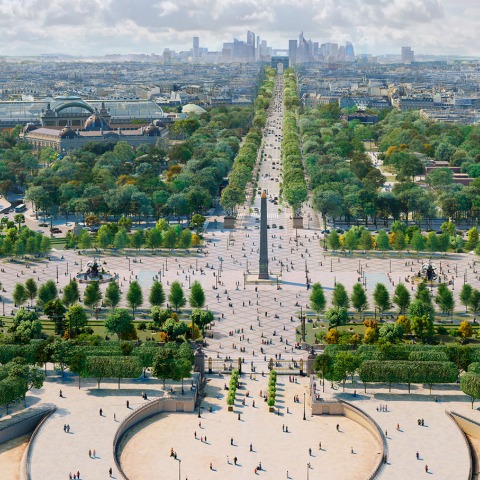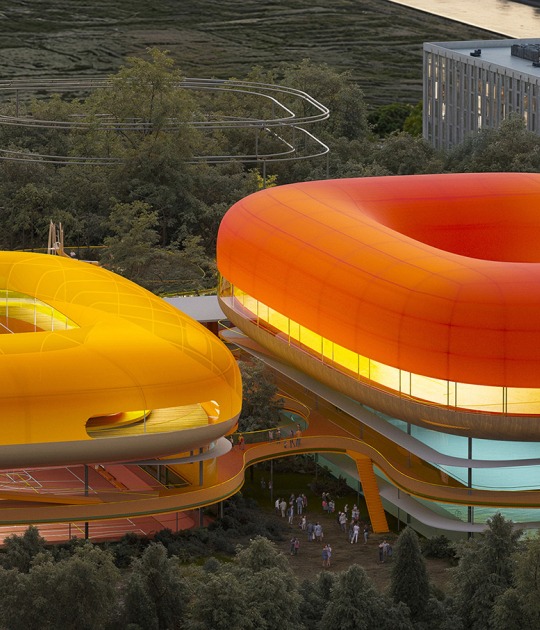With the support of a team of researchers and creatives, PCA-STREAM presents a scientific and multidisciplinary, sensory and analytical approach, to address this urban phenomenon in all its systemic complexity. The Champs Elysees are becoming a collective space to experiment with the development of a sustainable, desirable, and inclusive city by 2030, focusing on four main strategic priorities: reducing the impact of urban mobility, rethinking nature as an ecosystem, seeking new uses, and the use of data for measurement and regulation.
Description of project by Philippe Chiambaretta
On the Champs-Élysées, the city was built with the prospect of infinite progress. Three centuries after their creation, cars, noise, pollution, tourism, globalization of the commercial offer, abandoned gardens are harming the use of the avenue and its appropriation by Parisians. The Champs-Élysées, Histoire & perspectives exhibition presents the study carried out at the initiative of the Champs-Élysées Committee by Philippe Chiambaretta with the collaboration of some fifty French researchers, historians, scientists, engineers, artists, economic and cultural players. and international. It traces the evolution of the "most beautiful avenue in the world", analyzes its current uses, and offers a vision of its possible evolutions concerning contemporary issues. She also invites everyone to participate in their metamorphosis.
Through drawings, films, unpublished photographs, engravings, and specially created maps, the exhibition traces the history of this avenue imagined by Le Nôtre in 1664, baptized Champs-Élysées from 1709, and arranged by Jacques-Ignace Hittorff and Adolphe Alphand in the 19th century. It also questions its current state and the issues arising from modern ambition, as well as neglected gardens. Today, two-thirds of passers-by on the Champs-Élysées are tourists, 85% of whom come from abroad. If we remove those who work in the neighborhood and people in transit (less than 15 minutes in the neighborhood), Parisians only represent 5% of users of the avenue.
As part of the global awareness of a necessary change in this territory given the context of environmental crisis, demographic acceleration, and widening inequalities, the exhibition and the book that accompanies it re-examine the potential of the avenue with the ambition of linking it locally to major contemporary urban issues. Decrease the number and intensity of heat islands, make the soil more permeable, increase the vegetation surfaces, facilitate soft mobility, enhance the heritage and existing gardens, invent new types of financing or partnerships, design, and program in a concerted and inclusive manner, build while consuming less, to finally allow residents to reclaim their Champs-Élysées.
To invite everyone to participate in the debate and this metamorphosis, the event is designed as a collective and participatory adventure. Engaged at the initiative of the economic and cultural players of the avenue, the diagnosis and perspectives become supports for discussions, debates, and exchanges via the Make.org platform. At the same time, educational workshops make it possible to raise awareness among young audiences and schoolchildren, urban walks offer immersion in situ, conferences bring together experts and actors around the social, urban, and architectural issues of this unique territory.
A VISION FOR 2030
The history and the current diagnosis of the Champs-Élysées make it possible to establish the unique symbolic link that links their destiny to Western urban development. The deterioration since the 1970s in the conditions of the avenue reflects the global destabilization of ecosystems. Our vision to re-enchant the avenue by 2030 invites us to bring together the research and resources of all public and private actors to make this territory a laboratory of excellence for more sustainable, more desirable, and more inclusive cities.
WHAT WOULD BE THE CONSEQUENCES OF THIS VISION?
The conceptual framework of the study captures the complexity of urban metabolism and generates principles of action whose effects are quantifiable. Indicators make it possible to tangibly assess the impact of these actions concerning the three objectives of sustainability, desirability, and inclusiveness. An initial assessment established with all of our partners shows promising results, which will need to be completed and updated throughout the development of our approach.
HOW TO SHARE THIS VISION?
The urban transformations necessary to face the major planetary challenges can no longer be decreed only from above. They must be able to be appropriated by everyone. The Champs-Élysées provide the setting for a unique experiment in responsible co-design because they constitute a sufficiently well-known and common territory to allow everyone to participate in the making of the city of tomorrow.
HOW TO FINANCE THIS VISION?
The financing of the ecological transition of cities cannot be supported by the power of States and public authorities alone. The production of the city must call more and more on forms of partnerships in which the private sector participates to its rightful extent in the management of externalities ignored until then. The cost-sharing of making the common space already exists in other European capitals. Likewise, the Champs-Elysées, a national symbol, could be the subject of an innovative approach in terms of transforming and financing our living environment, thus regaining their role as an inspirer of new models.





































































